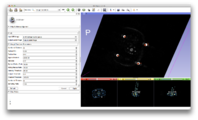Difference between revisions of "Documentation/4.2/Extensions/circlesDetectionHoughTransform"
From Slicer Wiki
(Created page with '<!-- ---------------------------- --> {{documentation/{{documentation/version}}/module-header}} <!-- ---------------------------- --> <!-- ---------------------------- --> {{doc…') |
|||
| Line 41: | Line 41: | ||
* Mosaliganti K., Gelas A., Cowgill P., Megason S. An Optimized N-Dimensional Hough Filter for Detecting Spherical Image Objects. 2009 Sep. | * Mosaliganti K., Gelas A., Cowgill P., Megason S. An Optimized N-Dimensional Hough Filter for Detecting Spherical Image Objects. 2009 Sep. | ||
[http://hdl.handle.net/10380/3129] | [http://hdl.handle.net/10380/3129] | ||
| + | * Pernelle, Egger, Vale, Chen, Irlinger, Lueth, Wells, Kikinis, Viswanathan and Kapur. Robust Applicator Registration for Interstitial Gynecologic Brachytherapy. ABS 2013 Annual Meeting (submitted) | ||
<!-- ---------------------------- --> | <!-- ---------------------------- --> | ||
Revision as of 19:46, 21 November 2012
Home < Documentation < 4.2 < Extensions < circlesDetectionHoughTransform
Introduction and Acknowledgements
Authors: Guillaume Pernelle
Contributors: Guillaume Pernelle
Contact: Guillaume Pernelle, <email>gpernelle@gmail.com</email>
Website: https://github.com/gpernelle/houghTransform
License: Slicer license
Extension Description
This modules performs a circles detection by implementing the itk class developed by The GoFigure Dev. Team. at Megason Lab, Systems biology, Harvard Medical school, 2009
Modules
Use Cases
Tutorials
No tutorial
Similar Extensions
N/A
References
- Mosaliganti K., Gelas A., Cowgill P., Megason S. An Optimized N-Dimensional Hough Filter for Detecting Spherical Image Objects. 2009 Sep.
- Pernelle, Egger, Vale, Chen, Irlinger, Lueth, Wells, Kikinis, Viswanathan and Kapur. Robust Applicator Registration for Interstitial Gynecologic Brachytherapy. ABS 2013 Annual Meeting (submitted)
Information for Developers
This is a CLI module. The output is written into a file situated in the same place as where the module is executed. This file can be read back into slicer, see an example of a python script here: python script using json A radius information is also available, please uncomment this part of the code to access it: Radius output
